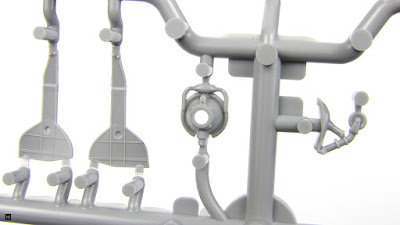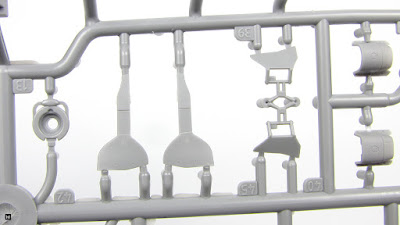Ki-84 Hayate “Special Attack Units”

The newest edition of the 1:72 scale Ki-84 Hayate model kit from Arma Hobby focuses on the machines from Special Attack Units, commonly known as Kamikaze. Let's take a closer look.
Disclaimer
The review sample was kindly provided by the manufacturer. Thanks, Arma Hobby.
The kit
The front of the side-opening box with the catalogue number 70053 features an illustration by Piotr Forkasiewicz. Very nice to be honest.
Inside one will find a set of plastic sprues, sheet of self-adhesive masks, markings in the form of decals and an assembly manual.
The contents largely echoes elements from the previous editions, which have also been covered here (see reviews of “Expert Set” & “Model Kit”).
Grey plastic
Let's get down to specifics, starting with the fuselage, which is unsurprisingly split into two main parts.
On which we find rather thin, recessed panel lines, a handful of similarly reproduced rivets and fasteners, and a subtly stressed rudder covering.
Author of the project took a rather unconventional approach to the cockpit area, where the upper part of the fuselage was designed as a separate element. In two versions, depending on whether one wants to make a model with open or closed cockpit canopy.
The engine fairing was also handled in an original way – section was reproduced together with the fuselage halves, the rest has to be glued separately.
A somewhat unimpressive looking exhaust pipes are covered by rather nice cowling gills. The latter are only available in the closed position, which is a bit disappointing, since they are a separately glued element anyway.
The oil cooler, however, has been prepared in two variants – early (smaller) and late (larger). But this time only one of them will be used (spoiler: the smaller one, parts 28 and 29).
Elements of the cockpit structure and equipment can be found on the inner side of the fuselage halves.
An unconventional solution, although already known from this manufacturer's earlier models, was implemented in the cabin rear bulkhead, designed together with the seat supporting rack, which has to be bent forward a bit.
Speaking of the seat – well, it's not great, to put it briefly. The thickness is basically unavoidable in plastic. Small sinkmark in the middle is also no surprise. However, I don’t understand the practice of defining holes with raised lines. In my opinion it is neither pretty, nor realistic, nor helpful.
On the cabin floor one will find a whole bunch of raised lines, marking both panel edges and openings.
An interesting solution was implemented regarding the installation of control sticks, which are inserted from the bottom, thanks to which they reside in small recesses below the floor level.
There’s a little bit to complain about the rudder controls. No, not because they are clunky – in that respect it’s not bad. However, as far as I know the whole thing should form slight arc, while the pedals are set on a straight as a die bar (by the way – the element next to it is the gunsight base).
The raised lines are not a problem on the instrument panel, mounted to the front cockpit bulkhead, which features, among other things, rears of the fuselage guns.
To finish the subject of the cabin equipment – there are also some handles to be mounted on the floor (part no. 3) and the fuselage wall (11).
The miniature Nakajima Homare engine looks quite promising – two full rows with nice cylinder details and tabs to make it easy to install the finished unit inside the fuselage (where the appropriate mounting holes are located).
In addition – a separately glued front with pushrod covers (in two parts) and a reduction gear cover.
If you want to make a miniature with a spinning propeller, take an early interest in the back of the last part and place (not glue!) the propeller shaft (12) there.
On which you can later mount a four-bladed, one-piece propeller covered by a spinner.
The upper surfaces of the wing are in one piece, covered with a grid of recessed panel lines and a handful of other details. Exactly the same applies to the lower surfaces.
In both cases, subtly stressed ailerons looks very nice.
The barely visible sinkmarks at the wing-fuselage transition are almost not worthy of any attention.
Unlike the wing gun barrels (54) and asymmetrically mounted fuel cooler (55).
The element that holds the upper surfaces of the wings together is the quite deep main landing gear bay. It is a pity that raised lines were used here as well.
Slots for mounting the struts are in the lower part of the wings.
“Weighted” wheels aren’t very impressive – just like the original. Although some tyre tread would have been nice.
As well as some riveting on the covers. However, the reproduction of the inner segments' closing mechanism is a nice touch.
As a final word on the subject of landing gear – the quite nice tailwheel.
And its covers.
The elevator is reproduced together with the horizontal stabiliser.
Yes, with quite nice covering sagging.
In terms of underwing ordnance, the manufacturer has offered us a several options. Auxiliary tanks (200 litres) in two parts.
Two 100kg bombs, which won’t be used this time.
And one 250kg bomb, in two parts.
Apropriate load will be suspended on some pretty nice racks.
The only things left on the sprue are Pitote tube (57) and antenna mast (56).
So the “you're going to break it anyway” parts.
Transparent plastic
The small transparent sprue contains, as you can easily guess, mainly the elements for the cockpit canopy.
Quite nice by the way, thin and transparent.
With open position option.
The only element with a different purpose is the wing reflector.
The whole thing makes a really good impression and the sprue is protected by a separate ziplock bag – so there's not much to complain about.
Masks
Although Hayate's canopy doesn't look too complicated, the small sheet of masks, which will also help with painting the wheels, is a nice addition.
Especially cut in the well known and liked yellow Kabuki paper.
Decals
The included decal sheet was printed by Techmod, which has been a standard for Arma Hobby kits for some time now.
The print is clear, the colours uniform and saturated, and there are no layer shifts.
Small stencils and instrument panel gauges looks good too. However I'm not a fan of the pilot straps in this form and those are only one provided in this edition.
Anyway the whole thing looks excellent, at least on paper.
Manual
The booklet containing tips on building the model doesn’t differ too much from Arma Hobby previous ones. Clear and neat assembly drawings.
Plus additional comments appearing here and there.
The table with suggested paints includes references to Hataka (Orange Line), AK Interactive (Real Colors), MR Paint, AMMO, Mr. Color (seria „C”), Vallejo i Tamiya.
The machines that we can make using the box markings are presented on colour profiles.
Which also provide directions for decal placement.
Painting options
The kit in question let us build a Ki-84 fighter in one of three paint and markings variants. Those are.
Ki-84 Ko Hayate – 57 Shimbu-tai, pilot: Tadashi Kono, Miyakonojo airfield, Kyushu, Japan, 1945.
Ki-84 Ko Hayate – 58 Shimbu-tai, pilot: Lt. Toku Ueda, Miyakonojo airfield, Kyushu, Japan 1945.
Ki-84 Ko Hayate – 195 Shimbu-tai, pilot: Lt. Fujiyama Nobuho, Awaji, Yura Airfield, Japan 1945.
Of course all the machines, true to the set's subtitle, come from units that performed suicide attacks.
Summary
Kit from Arma Hobby is currently the best starting point for building a Ki-84 Hayate miniature in 1:72 scale. Add to that the interesting theme of this edition and the result is a proposition definitely worth considering.
I like it.



















































































